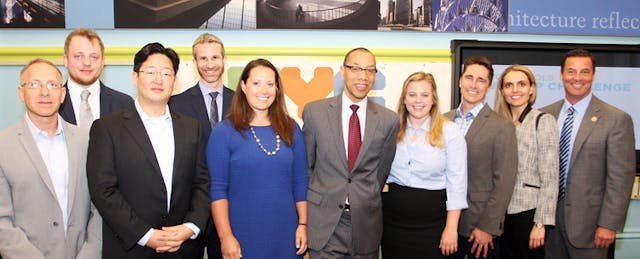On Tuesday, the New York City Department of Education took another step towards collaborating with outside developers on innovative school software by announcing the winners of its first ‘Gap App’ software challenge. KnowRe, Mathalicious, Hapara and LiveSchool were selected out of a field of 200 apps as promising programs that will be piloted in New York City schools starting this fall.
“Our students are really into technology,” said Schools Chancellor Dennis M. Walcott at the Tuesday press conference, which was held at the DOE’s Manhattan offices. “If we can find different ways to engage them, it’s to the benefit of the entire system.” The Gap App challenge, which kicked off in January, was designed to do just that: close the ‘achievement gaps’ that persist in today’s schools by importing innovative apps and fresh ideas from outside the school system. The challenge was also designed to closely tie developers with teachers or “experts in the edtech field with experts in the classroom,” as Deputy Chancellor David Weiner phrased it. A third goal was to help startups and entrepreneurs break into the K-12 marketplace, which has traditionally been dominated by large, established companies. “[The DOE has] learned that we need to reach out to the tech community, that we can accelerate achievement that way,” said Weiner.
The inaugural Gap App competition, which the NYC DOE says is the country’s first-ever school district-sponsored software challenge, focused on math applications for middle school students and administrative/engagement tools for educators. Future challenges, which have yet to be announced, will have different targets.
While the Gap App winners were created outside the New York City school system, all were deemed a good fit for local teacher and student needs. Three panels of judges rated the Gap App submissions against an array of criteria. One judge--Dan Maccarone, CEO of the usability design firm Charming Robot--told EdSurge he primarily looked at app accessibility. “I asked, ‘Is this something someone can easily jump into?’”, explained Maccarone. “In this case, I was thinking about teachers and students, but it’s the same general idea I’d use when evaluating any product.” The four Gap App winners met that criteria, Maccarone added. “They all kept it really simple; they solved specific problems and didn’t try to do too much at once.”
KnowRe, which took first prize for instructional apps, creates a personalized review curriculum for each student via algorithms that measure math concept mastery. The data crunching happens behind the scenes, though. To students, KnowRe looks and feels like a game. Maccarone said he liked that KnowRe resembled Civilization and other popular video games. “If you’re going to go game-y with your app, it has to be up to the standards of things kids like and use,” he observed.
Steve Kinney, who teaches technology at Scholars’ Academy in Rockaway Park, Queens, was another Gap App judge. As a teacher, he said he assessed submissions by asking himself, “Would I use this tool in my own classroom?”
Mathalicious, which won second prize in the instructional app category, teaches math by focusing on real-world topics that naturally interest students, such as basketball, gadgets and space exploration. Its tagline: “Using math to learn about the world, not just learning math.”
Hapara, which nabbed the top Gap App prize for administration/engagement apps, is a teacher dashboard that integrates school data to customize and organize Google Apps for teaching. Teachers are able to see a range of student work in Blogger, Picasa, and other Google tools at a glance.
LiveSchool, which took second place in that same category, tracks student behavior on an iPad app so teachers can ditch the paperwork and data entry normally associated with keeping behavioral records.
Representatives from the four winning apps attended Tuesday’s press conference. Anthony Meyer, whose eponymously named foundation funded the winners’ prizes ($50,000 in cash and $54,000 in Amazon Web Services credits), also gave a short speech. In addition to the four winners, the NYC DOE recognized five Gap App contestants with honorable mentions: Algebra Touch, Chalkable, Fluid Math, Fraction Planet and Woot Math.
The Gap App competition is the brainchild of Innovate NYC, an initiative that functions as the R&D lab for a group of 250 New York City schools called the iZone. Schools accepted into the New York City iZone are tasked with exploring innovative teaching methods and technologies to support personalized learning.
The DOE only expected to get about 40 submissions to the Gap App challenge, said Deputy Chancellor Weiner. Encouraged by the response, the NYC DOE plans to host additional competitions. “The ROI is about as high as you’ll see in any educational endeavor,” Weiner told EdSurge.
The Gap App winners will next partner with specific New York City schools to implement and adapt their apps. Weiner said he anticipated that work to start this fall. Schools won’t be limited to choosing from the four winners or the nine finalists; Weiner said all Gap App submissions will be made available to schools. Schools will be able to choose how many Gap Apps to pilot and how large they want their trial to be.
Kinney, the Scholars’ Academy teacher, said his school was likely to adopt at least one Gap App app. Teachers will likely evaluate apps and hash out details with school administrators this fall, said Kinney.
Weiner said the NYC DOE plans to share data about the Gap App trials with other school districts in about a year. Fellow members of the League of Innovative Schools have expressed interest in holding similar software challenges, said Weiner.


